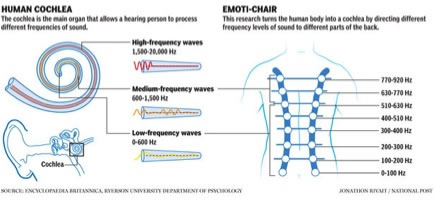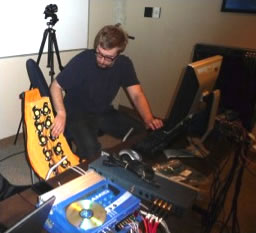Studies in Sound and Vibration
VibraFusionLab, An innovative centre for arts-based vibrotactile research and creative practice
VibraFusionLab is an innovative media arts centre based in London, Ontario that provides opportunities for the creation and presentation of multi-sensory artistic practice, partnering with other arts and technology-related organizations in order to achieve this. As an interactive creative media studio VibraFusionLab promotes and encourages the creation of new accessible art forms, including the vibrotactile, and focuses on inclusive technologies that have the potential of expanding art-making practices in the deaf, blind, disabled and hearing communities, and for creating more inclusive experiences for deaf, blind, disabled and hearing audiences.
Providing the opportunity to create compositions and expand artistic practices that are designed to be experienced as tactile stimuli (rather than acoustic sound), this art form is accessible to hearing, deaf and hard-of-hearing artists and audiences alike. VibraFusionLab represents considerable potential in generating artistic development and innovative research in vibration and the tactile as an artistic modality. It furthers our desire of combining alternative language, communication and emotional strategies and experiences into artistic practice. In addition, the use of this type of interactive multimedia, multisensory approach provides those with different abilities to enjoy equal participation. It provides the potential for making various forms of artistic expression more accessible. It offers new and unique approaches for those with differing abilities to produce art using an innovative tactile mode and opens alternative opportunities through artistic expression and to explore the integration of sound and vibration with the tradition of physical and emotional healing practices in various cultures.

Over the last decade, consumers have witnessed a dramatic increase in the use of low-fidelity, discrete vibrotactile feedback to enhance or replace audio stimuli in entertainment systems. However, use of high-resolution, continuous vibrotactile displays remains quite uncommon. The Emoti-Chair is a high-resolution, continuous vibrotactile display that may be driven by any type of audio signal and is purported to convey the emotional properties of sound through organized vibrotactile stimulation. In the study reported in the paper, we examined the ability of the Emoti-Chair to convey the emotional content of the soundtrack in a horror film. The Emoti-Chair project was developed by the Inclusive Media and Design Centre (formerly Centre for Learning Technologies) at Ryerson University in Toronto, Ontario. The research concept was to develop a theatre chair for the purposes of presenting a tactile vibrational representation of the movie audio files.
The technology separates audio signals into discrete vibrotactile output channels (voice coils) that can be presented on the body to create a high-resolution audiotactile experience through direct connection with musical instruments, live sound and digital sound files.
Tactile Audio Displays (TA) was founded after several years of research, resulting in the first version, the Emoti-Chair, which was used to increase access to sound from movies and music for deaf and deaf/blind audiences. TAD is a network of partners who have formed an ecosystem of engineers, developers, artists, researchers, business developers, technicians and academics working on the common goal of developing a new way to communicate to the body. Their partners include leading professionals and companies in three countries who have been working together since 2007.

Today a partnership between Inclusive Media and Design Centre, TAD and VibraFusionLab has resulted in this one-of-a-kind innovative studio space in London, Ontario. Other collaborative projects are underway with Tangled Arts + Disability (Toronto), Project Re•Vision, REDLAB / Revisioning Differences Mobile Media Arts Lab (University of Guelph) Deep Listening Institute (Rensselaer Polytechnic Institute in Troy, NY) Department of Disability Studies at Kings College (University of Western University, London, ON), InterAccess and the Music Gallery (Toronto), Inter Arts matrix (Waterloo, ON) and Centre3 (Hamilton).
In the inaugural year of the VibraFusionLab, invited visiting artists and musicians from Canada, United States and United Kingdom have included Gordon Monahan, Marla Hlady, Ellen Moffat, Isabella Stefanescu, Rick Sacks, Jason Doell, Emilie Lebel, Gayle Young, Allison Cameron and Brent Lee, as well as deaf artists Chisato Minamimura, Alison O’Daniel, Catherine McKinnon and Tiphaine Girault.
Social top